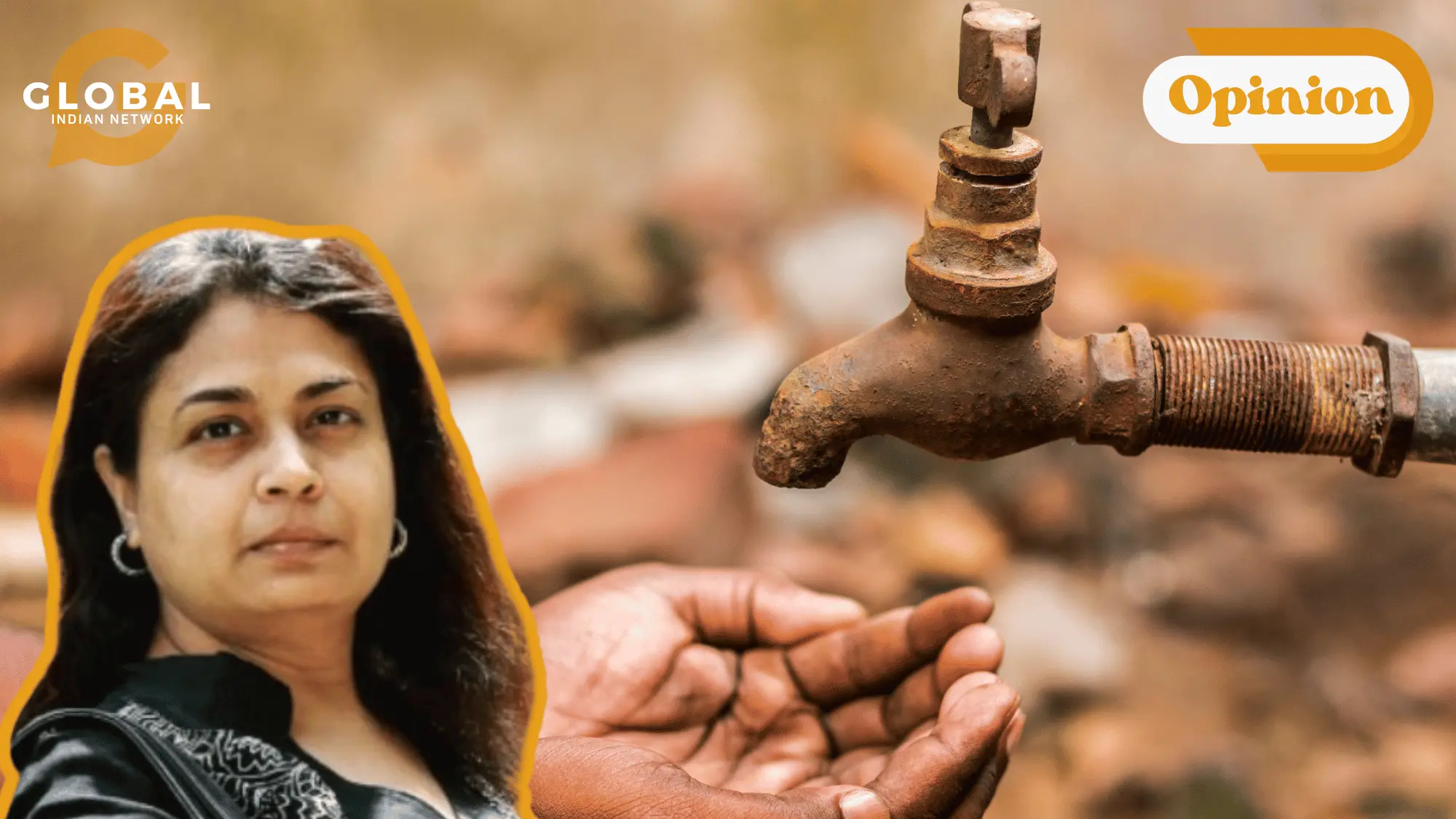What is the global water crisis?
We all know that 70% of the Earth’s surface is covered with water.
Yet, why is there a water scarcity?
Almost 70% of freshwater is frozen in glaciers and, therefore, not directly available. In short, it is estimated that the drinking water available on Earth does not exceed 2.5% of total water.
The global water crisis is caused by insufficient access to clean and safe drinking water, as well as inadequate availability for various uses. It includes the scarcity of freshwater resources and the deterioration of water quality. Overpopulation, climate change, pollution, and poor water management practices contribute to this crisis.
According to the World Wildlife Fund (WWF), on a global scale, more than one billion people worldwide suffer from serious water shortages all year. 2.7 billion people suffer from water scarcity for at least one month a year.
Scientists estimate that until the year 2025, a shocking two-thirds of the global human population may suffer from water scarcity.
Water scarcity in India
India faces water challenges due to its population, climate patterns, and mismanagement. The crisis is characterized by regional disparities, with some areas experiencing shortages.
Every year, 200,000 Indians die because they do not have access to clean water. People die from dehydration or disease caused by poor water quality. If this continues, by 2030, almost 60% of India’s aquifers, and with them, 25% of the country’s agricultural production, will be in critical condition. India’s per capita water availability in 1951–2001 decreased from 5,177 liters to 1,820 liters per year and is expected to reduce to 1,140 liters per person by 2050. (Source: www.earthandhuman.com)
The yearly water availability per person has decreased by 75% in the 75 years since Independence, from 6,042 cubic meters in 1947 to 1,486 cubic meters in 2021. (Source: www.clearias.com)
Significance of addressing water scarcity
Clean water is essential for human survival and agriculture, as well as for various industries such as manufacturing, energy, and tourism. Water scarcity can lead to food shortages, rising prices, and disrupt economic activities. Additionally, maintaining ecosystems and biodiversity relies on adequate water resources, and scarcity can harm ecosystems and disrupt natural cycles. Water scarcity can also lead to conflicts over access to water resources, making it a potential source of geopolitical tension.
Water scarcity is important for several reasons: it can threaten human survival by causing waterborne diseases, lead to food shortages and rising prices due to its vital role in agriculture, disrupt economic activities in various industries, harm ecosystems and biodiversity, and cause conflicts over access to water resources.
How do we know there is a water scarcity?
The Falkenmark Index, also known as the Water Stress Index, is one of the most commonly used measures of water scarcity. It defines water scarcity as the total water resources that are available to the population of a region, measuring scarcity as the amount of renewable freshwater that is available for each person each year.
If the amount of renewable water per person per year in a country is below 1,700 m3, the country is said to be experiencing water stress. If it is below 1,000 m3, it is said to be experiencing water scarcity. If it is below 500 m3, it is experiencing absolute water scarcity.

Causes

The issue of the water crisis is multifaceted and affected by various factors. Climate change, population growth, and inefficient use of water resources have been identified as key contributors to this problem. Climate change can lead to changes in precipitation patterns and water availability, exacerbating the water crisis. Population growth puts additional strain on water resources, increasing the demand for clean water for drinking, sanitation, and agriculture. Inefficient use of water resources refers to practices that result in wastage or unsustainable water consumption.
As per the scientists, there is an urgency to act to address the water crisis. The report likely provides evidence and analysis of the severity of the situation, emphasising the need for immediate measures. By drawing attention to the protection of freshwater ecosystems, the report underscores the interconnectedness between water availability and the health of natural habitats. Preserving these ecosystems is crucial for maintaining biodiversity, supporting livelihoods, and ensuring a sustainable supply of clean water for human use.
Overall, this text emphasises the importance of recognising and addressing the complex factors contributing to the water crisis. It calls for urgent action to mitigate the impacts of climate change, manage population growth, and promote sustainable use of water resources. Protecting freshwater ecosystems is crucial to protecting a resilient and sustainable water supply for current and future generations.
Effects

Water scarcity refers to a situation where there is a lack of enough water resources to meet the needs of a particular region or population. This shortage of water has significant and wide-ranging impacts on both the natural environment and society. Some of the critical consequences of water scarcity include the following:
Droughts and Crop Failures: Water scarcity leads to droughts, which are prolonged periods of abnormally low rainfall. Droughts can result in crop failures and food shortages, affecting agricultural economies and food security.
Health Impacts: Limited access to clean water can lead to the spread of waterborne diseases. Contaminated water can cause illnesses such as cholera (a bacterial infection causing severe diarrhoea) and dysentery (an infection causing inflammation of the intestines). These diseases pose a health risk to communities.
Economic Disruption: Industries that rely on water, such as manufacturing and energy production, can be disrupted during periods of water scarcity. This disruption has economic implications and can lead to job losses.
Ecosystem Degradation: Water scarcity harms ecosystems, particularly freshwater ecosystems. It leads to the drying of wetlands and the decline of aquatic habitats, resulting in reduced biodiversity and harm to aquatic species.
Conflicts over Water: Competition for limited water resources can lead to conflicts and tensions between communities or nations. Water scarcity is a potential source of geopolitical disputes.
Migration and Displacement: In situations of severe water scarcity, people may be forced to migrate in search of water resources. This can lead to displacement and the creation of "water refugees," who are forced to leave their homes due to a lack of water.
Decreased Hygiene: Limited access to water for sanitation and hygiene purposes can lead to poor hygiene practices, increasing the spread of diseases.
Impact on Women and Children: Women and children are often disproportionately affected by water scarcity as they are typically responsible for collecting water for their families. This limits their access to education and economic opportunities.
Agricultural Challenges: Farmers face difficulties in irrigating their fields and providing water for their livestock during periods of water scarcity. This affects agricultural productivity and income.
Environmental Stress: Water scarcity contributes to environmental stress by leading to the overexploitation of groundwater resources and the drying up of rivers and lakes.
To mitigate these adverse effects and guarantee a more secure and sustainable water future, it is crucial to address water scarcity through sustainable water management and conservation practices.
Social impact
Water scarcity has various social impacts, including limited access to clean water leading to waterborne diseases, education disruption due to children, especially girls, fetching water, gender inequality with women bearing the burden of water collection, conflicts and tensions arising from competition for limited water resources, potential food shortages, displacement of people in search of water sources, livelihood impacts, exacerbation of social inequalities for vulnerable communities, stress on communities, and urban challenges. Addressing these impacts requires sustainable water management, infrastructure development, and fair access to water resources.

(Source:guardian.com)
One village in Maharashtra, Denganmal, has been in the news for an odd practice. The village has a population of 500 and is situated on rocky terrain with no water pipeline connections. The only water source in this village is the Bhatsa dam on a river and a well, which are far away from the village. Men in Denganmal have more than one wife, with some having up to four wives, one legal, and the rest three “paani bais” or “water wives”. These women walk through fields and mud tracks, carrying empty vessels on their heads, to fetch water from the river. Each vessel carries around 15 litres of water, and each woman usually carries two vessels on her head. (Source: indiatimes.com)

Fortunately, this practice is not seen in urban areas.
Predictions

A map of global water stress (a symptom of water scarcity) in 2019 is shown above. Water stress is the ratio of water use relative to water availability and is, therefore, a demand-driven scarcity.
According to the UN World Water Development Report of 2018, by 2050, 40% of people in India will face water scarcity due to climate change and rising demand, compared to 33% currently. India is also vulnerable to sea-level rise, which could lead to land submergence, flooding, erosion, and saltwater intrusion.
Solutions

Water scarcity is a complex issue that requires a multi-pronged approach to address it. Here are some solutions to water scarcity at different levels in India:
National level:
- Efficient use of water for agriculture through micro-irrigation techniques such as drip and sprinkler irrigation
- Revival of traditional aquifers while implementing new ones
- Government intervention at the source to tackle sewage and wastewater drainage into traditional water bodies.
- Strict monitoring and implementation of laws by the government, NGOs, and social activists to prevent the release of chemicals and effluents into rivers, streams, and ponds.
Regional/state level:
- Efficient water management practices like rainwater harvesting, conservation, and recharge should be adopted to reduce water waste and increase availability
- The development of a formal water policy is crucial. This will provide guidance to the administration and citizens on the proper usage of surface water and groundwater.
Neighbourhood/city level:
- Every independent home, flat, and group housing colony must have a rainwater harvesting facility. If efficiently designed and properly managed, this alone can reduce water demand significantly
- Wastewater treatment and recycling for non-drinking purposes
Personal level:
- Fixing leaking taps and pipes in homes can save a significant amount of water.
- Using a bucket instead of a shower while bathing can save up to 150 litres of water daily.
- Reusing gray water from washing machines for gardening can help reduce the demand for fresh water.
Water footprint
A water footprint measures the amount of freshwater used in producing goods and services at individual, community, or national levels. It includes direct and indirect consumption from agriculture, industry, and personal use. The three components are blue, green, and gray water footprints. Understanding water footprints is essential for making sustainable choices and managing water resources efficiently.
Blue Water Footprint: The amount of surface and groundwater used in producing a product or service, including water taken from rivers, lakes, and underground sources
Green Water Footprint: The water used from rainfall is stored in the soil and used by crops and vegetation during their growth
Gray Water Footprint: The freshwater required to dilute pollutants in wastewater to meet water quality standards
Steps taken by the government
The Jal Shakti Abhiyan is a national campaign by the Ministry of Jal Shakti in India. It aims to conserve rainwater and provide water security through collaboration between the Government of India and state governments, focusing on asset creation and communication to make water conservation a Jan Andolan.
Amrit Sarovar is a nationwide campaign launched by the Ministry of Jal Shakti in India to conserve water for the future. It aims to develop and rejuvenate 75 water bodies in each district of the country as part of the celebration of Azadi ka Amrit Mahotsav. The initiative was launched on National Panchayati Raj Day on April 24, 2022, with the objective of conserving water for the future. The campaign focuses on water conservation and security through a collaborative effort of various ministries and state governments. Its goal is to create awareness and promote water conservation among the public.
Atal Bhujal Yojana, Paani Bachao, Paisa Kamao, and Ganga Rejuvenation are some other projects.
World Bank projects
The World Bank is supporting India's efforts in the water sector through various projects, such as the National Mission for Clean Ganga, the Dam Rehabilitation and Improvement Project, the National Hydrology Project, the Shimla Water Supply and Sewerage Service Delivery Reform Development Policy Loan, and the West Bengal Accelerated Development of Minor Irrigation. Innovative financing instruments are being used, and analytical work is being conducted to incorporate results into future lending operations.
Conclusion
“The wars of the next century will be fought over water” is attributed to Dr. Ismail Serageldin, former Vice President of the World Bank; this statement was made in 1995 at a conference in Japan.
If we act prudently, there is no reason to reach that point.
It is imperative that we take immediate action to address the issue of water scarcity. By adopting sustainable practices and implementing effective policies at all levels of government and society, we can guarantee that everyone has access to safe drinking water.
Let us pledge to ourselves that we will take the necessary actions at (least) the individual level to curb the looming disaster.
Let each one of us add our ‘drop’ to the cause.
Let us know what you think in the comment section below. If you have an opinion to share, send it over to larra@globalindiannetwork.com.










The initial part of the article gives a discussion on theoretical aspects in the subject. Useful for people working on the subject. Latter part with reality solutions are useful for the common man.